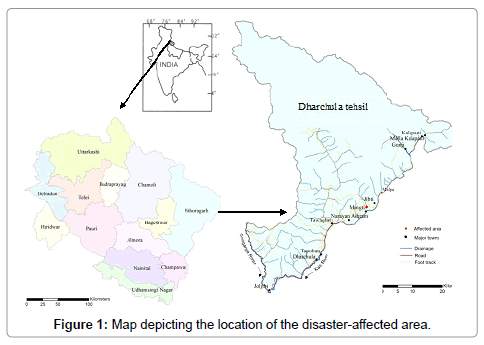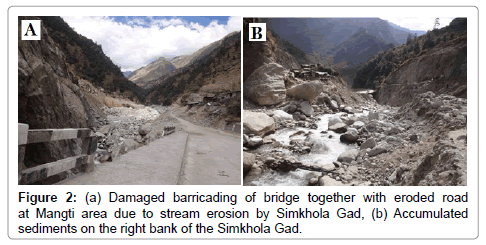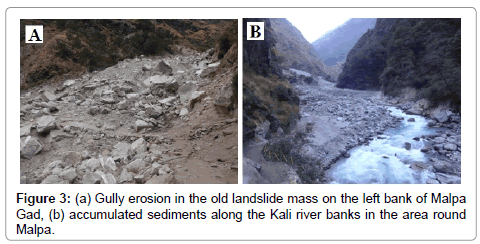Disastrous Events on Kelash-Mansarowar Route, Dharchula Tehsil in Pithoragarh District, Uttarakhand in India
Received: 15-Dec-2017 / Accepted Date: 06-Apr-2018 / Published Date: 10-Apr-2018 DOI: 10.4172/2157-7617.1000463
Abstract
This paper presents evidence of trends of fractal properties and long memory in three-month variations of radon in soil, in Lesvos Island, Greece. The methodology employed consists of sliding-window (a) detrended fluctuation analysis, (b) fractal analysis, (c) rescaled range analysis and (d) fractal dimension analysis with the methods of Higuchi, Katz and Sevcik. During measurements two mild earthquakes occurred in the vicinity. The results of the detrended fluctuation analysis revealed four peaks with slopes between 1.2 and 1.5. The fractal analysis method resulted in three peaks with persistent power-law exponent values in the range 2.2 and 3.0. The rescaled-range analysis indicated persistent Hurst exponents between 0.7-0.9 and in some segments, between 0.9-1. The fractal dimension analysis showed four peaks with fractal dimensions in the range 1.3-2.0 (Higuchi and Katz methods) and 1.0-1.5 (Sevcik method). The results were compared in terms of conversion to Hurst exponents. Several persistent segments were addressed, along with persistency-anti-persistency switching instances. Potential geological sources are discussed and analyzed.
Keywords: Dharchula; Flash floods; Losses; Causative factors; Suggested measures; Uttarakhand
Introduction
In the recent times extreme rainfall events have become common and recurring phenomenon in the Himalaya, especially in Garhwal and Kumaon regions of Uttarakhand and in most of the year’s extreme rainfall events were reported in August during the latter part of the monsoon season [1]. Kandauliya Gad, Uttarkashi (August, 1978), Kaunth, Chamoli (August, 1979), Thalisain, Pauri (August, 1989), Mandal, Chamoli (August, 1991), Bhenti, Rudraprayag (August, 1998), Malpa, Pithoragarh (August, 1998), Burakedar-Agunda, Balganga valley, Tehri (August, 2002), Lah- Jhekla, Pithoragarh (August, 2009) and Asiganga, Uttarkashi (August 2012) in different part of Uttarakhand are the evidences for extreme rainfall events [2-4]. It is observed that the debris flows were the main cause of devastation in all the previous extreme rainfall events and associated disasters.
As communicated by District Emergency operation Centre (DEOC) Pithoragarh flash flood incidences took place at Mangti and Malpa areas on 14 August 2017 amid heavy rainfall at early morning (2:30 am) in the catchment of the tributaries of Kali River, particularly Simkhola Gad and Malpa Gad. Flash floods and toe erosion induced by incessant heavy rainfall in the devastated areas led to loss of human lives, infrastructure and property. This also triggered landslide and debris flow at many places in the vicinity of the devastated areas. No vehicular movement to Mangti and Malpa was thus possible after this tragedy. However, rainfall data could not be recorded due to the absence of meteorological observatories in devastated areas. The details of the losses are summarized in Table 1.
| Head | Mangti | Malpa | Total |
|---|---|---|---|
| Persons dead | 1 | 8 | 9 |
| Persons missing | 8 | 10 | 18 |
| Persons injured | 4 | 1 | 5 |
| Animals lost | 51 | - | 51 |
| Vehicle lost | 2 | - | 2 |
| Army tent damaged | 3 | - | 3 |
| Shops damaged | - | 4 | 4 |
Table 1: Losses incurred in the Mangti and Malpa areas of Pithoragarh district due to the disaster of August 2017 (Data source: State Emergency Operations Centre, Uttarakhand).
These devastated areas were investigated after the disaster and traverses were taken around the affected sites to examine the slope instability. Preliminary geological investigations of the study area has been carried out on the basis of Survey of India toposheet numbers 62 B/12 and 62 B/16 on 1:50,000 scale and final field checks.
Literature Review
Pithoragarh: A disaster-prone district
Pithoragarh district is the easternmost frontier district of the Uttarakhand and falls in lesser and Higher Himalaya. Like any other hilly terrain of the state it is most vulnerable to natural disasters. Available extreme rainfall events are collected from various sources and are described in the sections below. During the monsoons of 1998 major rock fall occurred in Malpa that inflicted heavy losses in Malpa village in Pithoragarh district. More than 200 persons were killed in this incidence [4].
In the year 2005, near Dharchula and Munsiyari areas were badly affected due to cloudburst and heavy rainfall. A number of cultivation land and a bridge at Syangatha were washed off. Madkot area of Munsiyari has been destroyed due to lake formation by the Gori and Kali rivers [5]. The Kumaon region was hard hit by landslide and flash floods yet again in 2009 and 2010. In the year 2009, landslide disaster occurred on Kuity village on Berinag-Munsiari road. Two Villages namely Jhakhala and Lah were washed off and took 43 lives [6].
In August 2010 cloudbursts occurred on Munsiari area. Around 38 persons were died in this incidence [7]. 18 September 2010 initiated by heavy rainfall and cloudburst resulting in 19 deaths, widespread damage to property and infrastructures. Landslide hit a primary school at Sumgarh village, Tehsil Kapkot of Bageshwar district where alone 18 children died, and 25 children were severally injured [8]. Similarly, during the monsoon of 2016 as well Didihat, Bastari and Naulra villages of Pithoragarh district were devastated by debris flows and landslide incidences that took toll of 21 human lives [9]. Because of close vicinity of Main Cenrtal Thrust (MCT) zone, the area located in earthquake sensitive region and often experiencing seismic tremors. The area also lies in the high Seismic Zone V [10] and earthquakes of 1979 and 1980 in Dharchula tehsil ravaged several villages along the Kali valley.
The study area
The area investigated lies in the Higher Himalaya in Dharchula Tehsil of Pithoragarh district of Uttarakhand, India and falls in the catchment of Kali River which makes the International boundary between India and Nepal (Figure 1). Enroute to pilgrimage around Kailash- Mansarovar in Tibet, Chota Kailash and Om Parvat in this region are main attractions. The devastated Mangti area (N 30°00'36.211" and E 80°43'7.925") is located at a distance of 30 kilometers from Dharchula town on the roadway. Malpa area (N 30°03'10.959" and E 80°46'12.755") can be approached by road till near Jibti village that is located at a distance of 36 km towards NNE direction from Dharchula. From Jibti one has to travel on foot for around 7 kilometers to reach Malpa village.
Geomorphology and geology of the area
Geomorphologically, the area is observed to be dissected by several ridges with deep valleys, rising to an elevation of nearly 2050 meters at Malpa area and minimum about 1650 at Mangi area. Geomorphic features of glacio-fluvial/fluvial and colluvial origin are generally observed in the area. The devastated Simkhola Gad is flowing from N-S, suddenly change in nala at Bridge from E-W and then thereafter it is following previous trend while Malpa gad is flowing from N-S with a gradient of 30° and both finally meet with Kali river.
The devastated areas show complex landforms in which all aggradational and degradational features were present. In year 1998 huge amount of rock mass fell and destroyed Malpa village resulted huge landslide mass was accumulated over Malpa Gad. Similarly, a large amount of unconsolidated materials was also noticed along the left bank of Simkhola Gad in the area around Mangti. Cutting on the same materials was noticed in these areas by excessive discharge of the streams.
Geologically, the area falls in the Great Himalayan terrain comprises Precambrian ‘Central Crystalline Zone’ divided into the Vaikrita Group in the north and the Munsiari Formation in the south. The Vaikrita Thrust (VT) separates the Munsiari from the Vaikrita rocks. The Vaikrita Thrust and Main Central Thrust (MCT), both trending NW-SE. Gneiss interbedded with thin bands of biotite garnet schist of Munsiari Formation of Central Crystallines are observed around the Mangti area while quartzites interbedded with thin bands of garnetbearing sericite schist of Vaikrita Group in the Malpa area [11-13].
The rock exposures on the right bank of Simkhola Gad area were observed to comprise of gneiss interbedded with thin bands of biotite schist belonging to the Rungling Formation of Central Crystallines. The foliation planes were observed to dip towards NE at angles 65º. The joints were observed to dip at steep angles towards NE and SSW (75º/50º and 60º/190º).
The rock exposures in Malpa area were observed to comprise of massive quartzite interbedded with thin bands of garnet-bearing sericite schist belonging to the Pandukeshwar Formation of Vaikrita Group of Central Crystallines. The foliation planes were observed to dip towards NE at angles 55º. Other two prominent structural weaknesses (joints) were observed to dip towards WNW at very steep angles (80º/310º) and towards SSE at steep angles (55º/170º).
Disastrous events of 14 August, 2017
Going to the Border Post Army persons were camped near Mangti area on the left bank of Simkhola Gad on 13 August, 2017. They were also parked their vehicles on the road and bridge at the same place. According to the local people, at early morning (2:30 am) high flash flood discharge of the Simkhola Gad contributed to the instability of the hill slopes of the Mangti area. The course of this gad was temporary blocked and water saturated debris overran the bridge, road and other structures. Around 50 meters road was washed off while barricading of bridge was also damaged in this incidence (Figure 2a). A number of places upstream to bridge around 2-3 meters thick pile of sediments were deposited on the right bank of Simkhola Gad (Figure 2b). The deposited sediments were observed to comprise of debris consisting of grey, fine grained silty matrix with rare boulders and fragments of schist and gneiss. As many as 9 persons were killed in this incidence. Of these bodies of 08 could not be recovered. Total of 3 Army tents and 2 vehicles were damaged and 51 cattle were lost. Because of loose soils/overburden and low level, damage or destruction mostly occurred along the left bank. Besides flash flood, landslides are also observed on the downhill and uphill side to devastated area along the road section.
On the same day, flash flood incidence took place at Malpa area in Pithoragarh district. Some of the habitation was situated over the old landslide mass and close to Malpa Gad at bottom of the hill slope. The excessive stream water eroded the old landslide mass on the left bank. The vertical height of the eroded cut is around 8-10 meters and width along the gad is around 120 meters. The overburden materials were observed to comprise of debris consisting of grey, fine grained silty matrix with rare boulders and fragments of quartzites. The pedestrian route leads to Kailash-Mansarover together with bridge were washed off in this incidence. Gully erosion is to be largely responsible for the devastation in the area (Figure 3a). As many as 8 persons were died and 10 persons went missing while 4 shops were damaged due to water saturated debris flow in the eastern side to Malpa gad area. As also, due to fast pace of stream water, sediments have been dumped at various places along the Kali river banks just downstream to affected area (Figure 3b).
Causative factors and suggested measures
Localized heavy rainfall was observed in the areas around Mangti and Malpa in Pithoragarh district in the night of 13 August as also in early hours of 14 August 2017, resulted in flash floods and toe erosion in the Simkhola and Malpa gads respectively, which eventually turned into a disaster. These inflicted heavy losses of human lives, property and infrastructures in devastated areas.
Heavy rainfall induced debris flows through streams was the main triggering factor for slope instability in the affected areas. Additionally, steep slopes, high altitudes, structural weaknesses and infrastructure development initiatives in close proximity of streams, over loose soils/ overburden deposits are the other causative factors.
The devastated areas as Mangti and Malpa in Dharchula tehsil of Pithoragarh district covered under the present study are observed to face flash flood incidences. After the careful examination of geological and geo-environmental history of the area, the following suggestive measures are suggested:
• It is suggested that appropriately designed bank protection walls should be constructed along the Simkhola Gad at Mangti area where road was washed off by stream. This practice will protect the road as well as bank of Simkhola Gad from stream erosion. Besides, damaged barricading of exist bridge should also be repaired.
• In the future, existing bridge of Mangti also needs to be relocated to upstream. This would protect the road along with left abutment of Bridge from the threat of flash flood.
• It is suggested that reconstruction of washed off pedestrian trek and bridge around the Malpa area. Alternative connectivity options, such as rope-ways would be better suited for the hills.
• In future recurrence of extreme rainfall events cannot be ruled out and therefore development like temporary camps, tourist camps and realignments of hazardous routes should be needed in safer location.
• Although it is difficult to forecast abnormally high precipitation and associated flash flood events, dense network of rain gauges is required for better understanding of this phenomenon.
• In view of the flash flood threat local population as well as other peoples are advised to stay away from loose soils/overburden materials and way of abandoned channels, particularly during monsoon.
Discussion and Conclusions
Kali Valley in Pithoragarh district experienced maximum destruction caused by abnormally high precipitation and associated disasters. Geodynamic evolutionary history of the region indicates that Kali Valley is prone to abnormally high precipitation and associated flash floods. Additionally, steep slopes, high altitudes, structural weaknesses, heavy rainfall and increasing anthropogenic interventions in close proximity of streams, over loose soils/overburden materials have added to the devastating potential of the disaster. Concentration of economic opportunities and other facilities in close proximity of the roads encouraged people to settle down by the road side. Increased inflow of trade, tourist and pilgrim traffic in the area only encouraged this trend. All these changes are responsible for enhanced flash flood risk in the area.
Field investigations and the record of recent extreme rainfall events in the region also suggest that the areas in the proximity of streams should be kept free of encroachment and anthropogenic activity of all kinds. Apart from stringent regulation people should be made aware of the risks faced in the vicinity of the streams. During monsoon, relocation of population and infrastructure from high risk areas are suggested as possible solutions. Temporary camps and other facilities in close proximity of streams, over loose soils/overburden deposits is also dangerous, especially during spells of heavy rainfall and therefore such localities should be banned. In case, these activities could not be regulated all suggestive measures would remain a mere formality.
Acknowledgements
We acknowledge guidance and support from the Executive Director, Disaster Mitigation and Management Centre, Department of Disaster Management, Government of Uttarakhand, India. All the colleagues at Disaster Mitigation and Management Centre and State Emergency Operations Centre are thanked; but for their commitment, support, cooperation and encouragement this work would not have been possible. Co-operation of the residents of the devastated areas and also the officials of the Pithoragarh district is acknowledged.
References
- Joshi V, Kumar K (2006) Extreme rainfall events and associated natural hazards in Alaknanda valley, Indian Himalayan region. J Mount Sci 3: 228-236
- Sajwan KS, Khanduri S (2016) A geological appraisal of slope instability in Upper Alaknanda Valley, Uttarakhand Himalaya, India. J Geol Geophys 5: 1-7
- Sah MP, Bist KS (1998) Catastrophic mass movement of August 1998 in Okhimath area Garhwal Himalaya. In Proceeding of International Workshop cum Training Programme on Landslide Hazard and Risk Assessment and Damage Control for Sustainable Development, New Delhi, India. pp: 259–282.
- Paul SK, Bartarya SK, Rautela P, Mahajan AK (2000) Composite Mass Movement of 1998 Monsoons at Malpa in Kali Valley of Kumaun Himalaya (India). Geomorphology 35: 169-180.
- Das S, Ashrit R, Moncrieff MW (2006) Simulation of Himalaya cloudburst event. J Earth Syst Sci 115: 299-313
- Kumar A (2013) Demystifying a Himalayan tragedy: Study of 2013 Uttarakhand Disaster, Ecology. J Indian Research 3: 106-116
- Das PK (2015) Global warming, glacial lakes and cloudburst events in Garhwal-Kumaon Himalaya: A hypothetical analysis. Int J Envir Sci 5: 697-708
- Kumar H, Mehrotra A (2011) Geotechnical assessment of landslides in the Bageshwar district of Uttarakhand, India. Disaster risk and vulnerability conference, School of Envir Sci, Mahatma Gandi University, India in association with the Applied Geoinfo Sci Envir, Germany pp: 121-124.
- khanduri S (2017) Disaster hit Pithoragarh District of Uttarakhand Himalaya: Causes and implications. Int J Geogr Nat Disast 7: 1-5
- Indian Standard (IS): 1893 Part I (2002) Criteria for earthquake resistant design of structures. Bureau of Indian Standards, New Delhi, India.
- Valdiya KS (1979) An outline of the structural set-up of Kumaun Himalaya. Journal of Geological Society of India 20: 145-157.
- Auden JB (1937) The structure of the Himalaya in Garhwal. Records of Geological Survey of India 71: 407-433.
- Heim A, Gansser A (1939) Central Himalayas: Geological observations of the Swiss expedition in 1936. Mem Soc Helv Sci Nat 73: 1-245.
Citation: Khanduri S, Sajwan KS, Rawat A (2018) Disastrous Events on Kelash- Mansarowar Route, Dharchula Tehsil in Pithoragarh District, Uttarakhand in India. J Earth Sci Clim Change 9: 463. DOI: 10.4172/2157-7617.1000463
Copyright: © 2018 Khanduri S, et al. This is an open-access article distributed under the terms of the Creative Commons Attribution License, which permits unrestricted use, distribution, and reproduction in any medium, provided the original author and source are credited.
Share This Article
Recommended Journals
Open Access Journals
Article Tools
Article Usage
- Total views: 5449
- [From(publication date): 0-2018 - Apr 03, 2025]
- Breakdown by view type
- HTML page views: 4329
- PDF downloads: 1120



